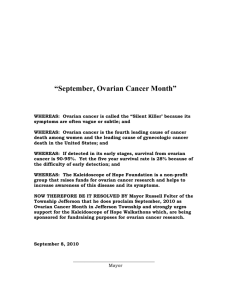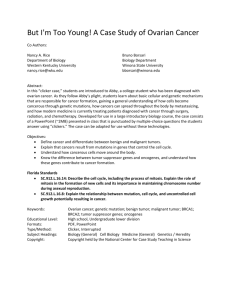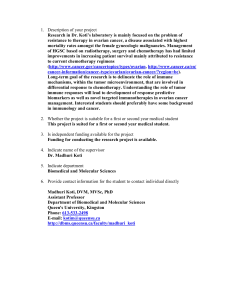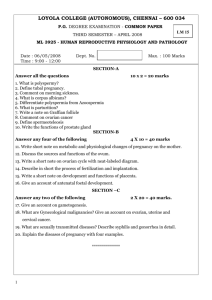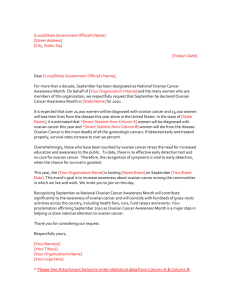Document 10763795
advertisement
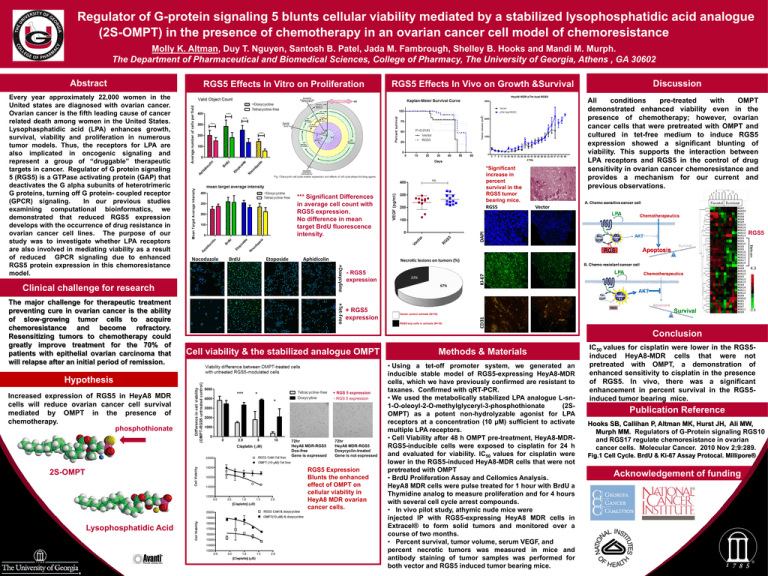
Regulator of G-protein signaling 5 blunts cellular viability mediated by a stabilized lysophosphatidic acid analogue (2S-OMPT) in the presence of chemotherapy in an ovarian cancer cell model of chemoresistance Molly K. Altman, Duy T. Nguyen, Santosh B. Patel, Jada M. Fambrough, Shelley B. Hooks and Mandi M. Murph. The Department of Pharmaceutical and Biomedical Sciences, College of Pharmacy, The University of Georgia, Athens , GA 30602 Abstract Every year approximately 22,000 women in the United states are diagnosed with ovarian cancer. Ovarian cancer is the fifth leading cause of cancer related death among women in the United States. Lysophasphatidic acid (LPA) enhances growth, survival, viability and proliferation in numerous tumor models. Thus, the receptors for LPA are also implicated in oncogenic signaling and represent a group of “druggable” therapeutic targets in cancer. Regulator of G protein signaling 5 (RGS5) is a GTPase activating protein (GAP) that deactivates the G alpha subunits of heterotrimeric G proteins, turning off G protein- coupled receptor (GPCR) signaling. In our previous studies examining computational bioinformatics, we demonstrated that reduced RGS5 expression develops with the occurrence of drug resistance in ovarian cancer cell lines. The purpose of our study was to investigate whether LPA receptors are also involved in mediating viability as a result of reduced GPCR signaling due to enhanced RGS5 protein expression in this chemoresistance model. RGS5 Effects In Vitro on Proliferation RGS5 Effects In Vivo on Growth &Survival *Significant increase in percent survival in the RGS5 tumor bearing mice. *** Significant Differences in average cell count with RGS5 expression. No difference in mean target BrdU fluorescence intensity. Discussion All conditions pre-treated with OMPT demonstrated enhanced viability even in the presence of chemotherapy; however, ovarian cancer cells that were pretreated with OMPT and cultured in tet-free medium to induce RGS5 expression showed a significant blunting of viability. This supports the interaction between LPA receptors and RGS5 in the control of drug sensitivity in ovarian cancer chemoresistance and provides a mechanism for our current and previous observations. RGS5 4.3 - RGS5 expression Clinical challenge for research The major challenge for therapeutic treatment preventing cure in ovarian cancer is the ability of slow-growing tumor cells to acquire chemoresistance and become refractory. Resensitizing tumors to chemotherapy could greatly improve treatment for the 70% of patients with epithelial ovarian carcinoma that will relapse after an initial period of remission. + RGS5 expression Conclusion Cell viability & the stabilized analogue OMPT + RGS 5 expression - RGS 5 expression Increased expression of RGS5 in HeyA8 MDR cells will reduce ovarian cancer cell survival mediated by OMPT in the presence of chemotherapy. phosphothionate 72hr HeyA8 MDR-RGS5 Dox-free Gene is expressed 72hr HeyA8 MDR-RGS5 Doxycyclin-treated Gene is not expressed RGS5 Expression Blunts the enhanced effect of OMPT on cellular viability in HeyA8 MDR ovarian cancer cells. Lysophosphatidic Acid Vector control animals (N=10) RGS5-exp cells in animals (N=10) Hypothesis 2S-OMPT -3.5 Methods & Materials • Using a tet-off promoter system, we generated an inducible stable model of RGS5-expressing HeyA8-MDR cells, which we have previously confirmed are resistant to taxanes. Confirmed with qRT-PCR. • We used the metabolically stabilized LPA analogue L-sn1-O-oleoyl-2-O-methylglyceryl-3-phosphothionate (2SOMPT) as a potent non-hydrolyzable agonist for LPA receptors at a concentration (10 µM) sufficient to activate multiple LPA receptors. • Cell Viability after 48 h OMPT pre-treatment, HeyA8-MDRRGS5-inducible cells were exposed to cisplatin for 24 h and evaluated for viability. IC50 values for cisplatin were lower in the RGS5-induced HeyA8-MDR cells that were not pretreated with OMPT • BrdU Proliferation Assay and Cellomics Analysis. HeyA8 MDR cells were pulse treated for 1 hour with BrdU a Thymidine analog to measure proliferation and for 4 hours with several cell cycle arrest compounds. • In vivo pilot study, athymic nude mice were injected IP with RGS5-expressing HeyA8 MDR cells in Extracel® to form solid tumors and monitored over a course of two months. • Percent survival, tumor volume, serum VEGF, and percent necrotic tumors was measured in mice and antibody staining of tumor samples was performed for both vector and RGS5 induced tumor bearing mice. IC50 values for cisplatin were lower in the RGS5induced HeyA8-MDR cells that were not pretreated with OMPT, a demonstration of enhanced sensitivity to cisplatin in the presence of RGS5. In vivo, there was a significant enhancement in percent survival in the RGS5induced tumor bearing mice. Publication Reference Hooks SB, Callihan P, Altman MK, Hurst JH, Ali MW, Murph MM. Regulators of G-Protein signaling RGS10 and RGS17 regulate chemoresistance in ovarian cancer cells. Molecular Cancer. 2010 Nov 2;9:289. Fig.1 Cell Cycle. BrdU & Ki-67 Assay Protocal. Millipore® Acknowledgement of funding
